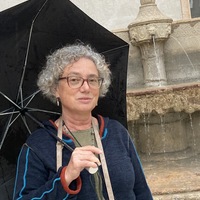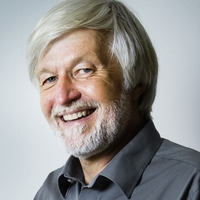
Ivanova Elena
Иванова Елена Юрьевна
профессор кафедры славянской филологии Санкт-Петербургского государственного университета (СПбГУ). Работает в СПбГУ с 1988 г.
доктор филол. наук (2003 г.) по двум специальностям 1) «Русский язык» и 2) «Славянские языки»
Elena Yu. Ivanova
Doctor of Sciences in Philology
Professor of the Chair of Slavic Studies at St. Petersburg State University
Phone: (812)328-95-24
Address: Санкт-Петербург, Университетская наб., д.11. Ауд. 168
профессор кафедры славянской филологии Санкт-Петербургского государственного университета (СПбГУ). Работает в СПбГУ с 1988 г.
доктор филол. наук (2003 г.) по двум специальностям 1) «Русский язык» и 2) «Славянские языки»
Elena Yu. Ivanova
Doctor of Sciences in Philology
Professor of the Chair of Slavic Studies at St. Petersburg State University
Phone: (812)328-95-24
Address: Санкт-Петербург, Университетская наб., д.11. Ауд. 168
less
Related Authors
Марина Джонова
Sofia University "St. Kliment Ohridski"
Anton Zimmerling
The Pushkin State Russian Language Institute
Ekaterina Lyutikova
Moscow State University
Галя Петрова
Assen Zlatarov University Burgas
Irina Mikaelian
Pennsylvania State University
Anna Plotnikova
Ural Federal University
Alexander Letuchiy
Vinogradov Russian Language Institute
Arto Mustajoki
University of Helsinki
InterestsView All (6)









Uploads
Papers by Ivanova Elena
The least studied function of the Bulgarian dative pronoun is that of the subject of opinion and appraisal. This function is realised primarily in the colloquial language and its written form – internet communication. The paper is focused on deadjectival verbs meaning “have a perceptively observable attribute denoted by the motivating adjective” (beleya ‘be/show white’, zhalteya ‘be/show yellow’, kiseleya ‘taste sour’, sladnya ‘taste sweet’), which may be used with a dative pronoun marking the subject of opinion (the subject of epistemic assessment, in particular) rather than the experiencer: Mlyakoto leko mi sladni. ‘The milk tastes somewhat sweet to me’. We also study the use of the dative pronoun with other verbs with the same word-formation structure (Glupee mi tozi vic. ‘This joke sounds (a bit) stupid to me’), as well as with predicates denoting interpretation.
Рассматриваются базовые средства выражения желания в болгарском языке в сопоставлении с русским. Основное внимание уделено болгарской «желательной» конструкции (Танцува ми се; Не ми се прибира), не имеющей полного эквивалента в русском языке. Анализируется ее специфика на фоне других средств выражения желания-личных и безличных желательных глаголов. На материале параллельных корпусов показано, как решается вопрос выбора переводческого соответствия при отсутствии эквивалента желательной конструкции в русском языке. Другой важной задачей нашей работы является обоснование семантических различий между желательной конструкцией болгарского языка (Не ми се работи) и рефлексивно-дативной русской моделью со значением состояния предрасположенности к действию (Мне не работается). Доказывается, что обе конструкции, имея, на первый взгляд, близкую структуру, характеризуются значительными грамматическими и семантическими различиями. Анализ параллельных текстов подтверждает, что для обеих конструкций отсутствует эквивалент в языке перевода, а для русской модели даже нет регулярного переводческого соответствия.
На материале параллельных текстов (ParaSol) устанавливаются русские эквиваленты македонских предложений с обобщенно-личным «човек» и выявляются структуры, наиболее адекватно передающие данное значение в русском языке
This article is devoted to semantic and grammatical properties of sentences with the Bulgarian particle da ne bi. Based on the Bulgarian National Corpus (8,400 contexts), the study outlines structural-semantic types of dependent and independent clauses with the particle da ne bi and their qualitative representation in the Corpus. It also defines conditions for the apprehensive interpretation of sentences with da ne bi. The analysis provides evidence in support of the assumption that the particle da ne bi should be isolated out of the entity da ne bi da, commonly treated as an integrated conjunction/particle, and shows grammatical consequences of the use of this particle for sentence structure.
основного значения депиктивов – актуального признака лица в момент совершения им того или иного действия. Материал болгарско-русского параллельного корпуса показывает, что, хотя в обоих рассматриваемых языках причастия могут функционировать как депиктивы, для русского языка их активность в этой функции,
по сравнению с болгарским, невелика; более характерным способом выражения сопровождающего состояния являются другие средства, в основном адвербиальные выражения. / The present article explores constructions with depictives (in conventional terms, predicative attributes), which constitute one of the forms representing the secondary predication. Participles in the depictive function are the most appropriate morphological means of expression of the current state of the subject at the moment of performing a certain action. The article shows, on the basis of the parallel Bulgarian-Russian corpus, that while participles can
function as depictives in the both languages, they differ in their depictive potential.
The article describes the results of a two-fold experiment aimed at identifying the active vocabulary of Bulgarian predicatives used to express the state of the subject in the impersonal construction including the dative of experiencer (Obidno mi e; Radostno mi e). The vocabulary of 320 items has been tested on native speakers of Bulgarian to obtain a ranked word list further correlated with a sample list from the Bulgarian National Corpus. The alignment of the two lists allowed to estimate the openness and productivity of the model, as well as the volume and structure of the Bulgarian predicative vocabulary.
Apart from their main function, the Bulgarian constructions with какъвто and както can express causal relations between the situations described in the main clause and the subordinate clause. The paper shows that in the causal use of both constructions the subordinate clause expresses a static feature, serving as a justification of the situa-tion presented in the main clause. In addition, there is a semantic differentiation be-tween the two models: какъвто normally expresses a usual (permanent) feature, while както denotes mostly a temporary (episodic) feature. Observations on the means used by Russian translators to convey this kind of causal meaning are also put forward.
The paper demonstrates the peculiarities of the formation of inchoatives derived from stative predicates by comparing these with verbs from other semantic types. Its main focus is on temporary-state predicates embedded in impersonal constructions and on corresponding inchoative verbs inheriting a number of obligatory structural elements of the impersonal model. The paper considers verbs of physiological, men¬tal state or emotions; substantive emotional, mental or physiological predicates; and inchoative desiderative predicates. Finally, the authors look into the potential for forming terminative prefixed derivatives only available for stative desiderative verbs.
Some important differences of inchoative verbs vs. their stative counterparts are the possibility of expanding the argument structure, the syntactic means of expres¬sion and the semantic content of the arguments. While stative verbs denoting physio¬logical, emotional or mental states are more likely to only express the dative experi¬encer, their inchoative correspondences usually can take additional arguments. Verbs of physiological states take arguments with the stimulus and locative (the part of the body affected by the state) roles; emotional verbs may express a stimulus and the ob¬ject of emotion; and mental verbs take an argument denoting the cognitive content and, possibly, an additional argument denoting the object of the cognitive content. Syntac¬tically, inchoative verbs allow both phrasal and sentential expression of some argu¬ments, while only one means of expression is available for their stative counterparts. In addition, the semantic content of some arguments is broadened to include gener¬alised situations and hidden predications. Unlike the previous three groups, inchoative desiderative verbs have the same argument structure as their stative counterparts and usually do not take arguments other than the dative experiencer.
The restricted productivity of the inchoative model is predetermined by seman¬tic and derivational factors, as well as by the competition with ‘phase verb + stative verb’ constructions.
В: Jezikoslovni zapiski. 25. 2019. № 1. С. 165-180.
https://ibl.bas.bg/wp-content/uploads/2020/07/PROCEEDINGS_IBLCONF2020_vol1a.pdf
В: XXV Державинские чтения : Современные и исторические проблемы болгаристики и славистики : Сборник статей по материалам XLIX Международной филологической конференции, посвященной памяти Людмилы Алексеевны Вербицкой (1936–2019). Санкт-Петербург, 2020 г. / Филологический факультет. СПбГУ ; отв. ред. Е. Ю. Иванова, З. К. Шанова. — Санкт-Петербург : ВВМ, 2020. — С.30-36.
The most frequent variant of the compound conjunction formed with the particle да had the same syntactic and grammatical properties as the conjunction макар (и) да in present-day Bulgarian, especially with regards to the contact position of да and the verb. By the time this conjunction was established, the formation of да-constructions was already clear: the verb immediately followed да (the two were separated mostly by pronominal clitics and negation as in present-day Bulgarian), while other clausal constituents were placed between макар (и) and да (in earlier texts, да and the verb could be separated by other clausal constituents as well).
The study also deals with the semantics of the concessive макар-conjunctions. The data shows that in the period considered, the expression of concession was still at its beginning. Therefore, clauses introduced by макар could express not only the prototypical ‘causal concession’ as in the present-day language, but could also have other interpretations within the semantics of concession. We also observe that макар clauses had additional paratactic semantics within the hypotaxis.
В статье на материале болгарских памятников XV-XVII вв. исследуются семантика и структура предложений, включающих новый для того исторического периода союз макар ʻхотя’, который затем в современном болгарском языке принял на себя функции основного уступительного союза. Основная часть исследуемого материал представляет собой сплошную выборку из текстов, расположенных на электронном ресурсе «Исторически корпус на българския език» (http://histdict.uni-sofia.bg/textcorpus/list). Союз "макар" представлен только в Валашских грамотах позднего периода и в двух новоболгарских дамаскинах (Троянском и Ловечском). Союз функционирует как в самостоятельном употреблении, так и в вариантах макар (и) да, макар че, макар (и) ако, макар и като. Дана характеристика союзов по способности вводить предикативные и непредикативные сегменты. Установлено, что для предложений с наиболее частотным вариантом, включающим модальную частицу "да", в исследуемый период были характерны те же линейно-синтаксические и грамматические свойства, которые имеет современный союз макар (и) да, – это прежде всего контактность да с глаголом. Таким образом, ко времени становления данного союза да-конструкция уже в целом была сформирована как жесткое грамматическое образование: да утратило возможность дистанционного нахождения от сказуемого подчиненной предикации, и, в результате этого, реализовывался разрыв компонентов самого союза частями подчиненной предикации для обеспечения контактности "да" и глагола. Особое внимание в данном исследовании уделяется семантике уступительных союзов. Материал свидетельствует, что в тот период выражение уступительных отношений еще находилось в стадии формирования, поэтому предложения с данным союзом выражали, в основном, не прототипическое для современного языка «причинно-уступительное» значение, а смежные с другими значениями варианты уступительной семантики. Как показывает исследование, для предложений с макар характерна и реализация дополнительной паратактической семантики в рамках гипотаксиса.
In: Studi Slavistici. XVII. 2020.1. 15-33.
We render the notion of обобщенноличность (generalized subjects) in traditional and formal descriptions of Modern Bulgarian and Modern Russian. "Traditional" and "formal" are merely tags, since there seem to be different definitions and different approaches to generalized subjects in the descriptions of Russian and Bulgarian grammar. Moreover, the formalization requires a critical survey of competing formal and semi-formal descriptions applying to the notion 'generalized subject' in semantics and/or surface syntax.
We argue that while the generalized (silent) subject argument of the 'обобщенноличные предложения' always have generic definitions, non-subject (overt) arguments of the generic situation can have specific referential status, contrary to the claims raised e.g. by A.Bondarko (1991).
Keywords: Russian, Bulgarian, corpus linguistics, sociolinguistics, variation, lexicon, grammar, predicatives.
The least studied function of the Bulgarian dative pronoun is that of the subject of opinion and appraisal. This function is realised primarily in the colloquial language and its written form – internet communication. The paper is focused on deadjectival verbs meaning “have a perceptively observable attribute denoted by the motivating adjective” (beleya ‘be/show white’, zhalteya ‘be/show yellow’, kiseleya ‘taste sour’, sladnya ‘taste sweet’), which may be used with a dative pronoun marking the subject of opinion (the subject of epistemic assessment, in particular) rather than the experiencer: Mlyakoto leko mi sladni. ‘The milk tastes somewhat sweet to me’. We also study the use of the dative pronoun with other verbs with the same word-formation structure (Glupee mi tozi vic. ‘This joke sounds (a bit) stupid to me’), as well as with predicates denoting interpretation.
Рассматриваются базовые средства выражения желания в болгарском языке в сопоставлении с русским. Основное внимание уделено болгарской «желательной» конструкции (Танцува ми се; Не ми се прибира), не имеющей полного эквивалента в русском языке. Анализируется ее специфика на фоне других средств выражения желания-личных и безличных желательных глаголов. На материале параллельных корпусов показано, как решается вопрос выбора переводческого соответствия при отсутствии эквивалента желательной конструкции в русском языке. Другой важной задачей нашей работы является обоснование семантических различий между желательной конструкцией болгарского языка (Не ми се работи) и рефлексивно-дативной русской моделью со значением состояния предрасположенности к действию (Мне не работается). Доказывается, что обе конструкции, имея, на первый взгляд, близкую структуру, характеризуются значительными грамматическими и семантическими различиями. Анализ параллельных текстов подтверждает, что для обеих конструкций отсутствует эквивалент в языке перевода, а для русской модели даже нет регулярного переводческого соответствия.
На материале параллельных текстов (ParaSol) устанавливаются русские эквиваленты македонских предложений с обобщенно-личным «човек» и выявляются структуры, наиболее адекватно передающие данное значение в русском языке
This article is devoted to semantic and grammatical properties of sentences with the Bulgarian particle da ne bi. Based on the Bulgarian National Corpus (8,400 contexts), the study outlines structural-semantic types of dependent and independent clauses with the particle da ne bi and their qualitative representation in the Corpus. It also defines conditions for the apprehensive interpretation of sentences with da ne bi. The analysis provides evidence in support of the assumption that the particle da ne bi should be isolated out of the entity da ne bi da, commonly treated as an integrated conjunction/particle, and shows grammatical consequences of the use of this particle for sentence structure.
основного значения депиктивов – актуального признака лица в момент совершения им того или иного действия. Материал болгарско-русского параллельного корпуса показывает, что, хотя в обоих рассматриваемых языках причастия могут функционировать как депиктивы, для русского языка их активность в этой функции,
по сравнению с болгарским, невелика; более характерным способом выражения сопровождающего состояния являются другие средства, в основном адвербиальные выражения. / The present article explores constructions with depictives (in conventional terms, predicative attributes), which constitute one of the forms representing the secondary predication. Participles in the depictive function are the most appropriate morphological means of expression of the current state of the subject at the moment of performing a certain action. The article shows, on the basis of the parallel Bulgarian-Russian corpus, that while participles can
function as depictives in the both languages, they differ in their depictive potential.
The article describes the results of a two-fold experiment aimed at identifying the active vocabulary of Bulgarian predicatives used to express the state of the subject in the impersonal construction including the dative of experiencer (Obidno mi e; Radostno mi e). The vocabulary of 320 items has been tested on native speakers of Bulgarian to obtain a ranked word list further correlated with a sample list from the Bulgarian National Corpus. The alignment of the two lists allowed to estimate the openness and productivity of the model, as well as the volume and structure of the Bulgarian predicative vocabulary.
Apart from their main function, the Bulgarian constructions with какъвто and както can express causal relations between the situations described in the main clause and the subordinate clause. The paper shows that in the causal use of both constructions the subordinate clause expresses a static feature, serving as a justification of the situa-tion presented in the main clause. In addition, there is a semantic differentiation be-tween the two models: какъвто normally expresses a usual (permanent) feature, while както denotes mostly a temporary (episodic) feature. Observations on the means used by Russian translators to convey this kind of causal meaning are also put forward.
The paper demonstrates the peculiarities of the formation of inchoatives derived from stative predicates by comparing these with verbs from other semantic types. Its main focus is on temporary-state predicates embedded in impersonal constructions and on corresponding inchoative verbs inheriting a number of obligatory structural elements of the impersonal model. The paper considers verbs of physiological, men¬tal state or emotions; substantive emotional, mental or physiological predicates; and inchoative desiderative predicates. Finally, the authors look into the potential for forming terminative prefixed derivatives only available for stative desiderative verbs.
Some important differences of inchoative verbs vs. their stative counterparts are the possibility of expanding the argument structure, the syntactic means of expres¬sion and the semantic content of the arguments. While stative verbs denoting physio¬logical, emotional or mental states are more likely to only express the dative experi¬encer, their inchoative correspondences usually can take additional arguments. Verbs of physiological states take arguments with the stimulus and locative (the part of the body affected by the state) roles; emotional verbs may express a stimulus and the ob¬ject of emotion; and mental verbs take an argument denoting the cognitive content and, possibly, an additional argument denoting the object of the cognitive content. Syntac¬tically, inchoative verbs allow both phrasal and sentential expression of some argu¬ments, while only one means of expression is available for their stative counterparts. In addition, the semantic content of some arguments is broadened to include gener¬alised situations and hidden predications. Unlike the previous three groups, inchoative desiderative verbs have the same argument structure as their stative counterparts and usually do not take arguments other than the dative experiencer.
The restricted productivity of the inchoative model is predetermined by seman¬tic and derivational factors, as well as by the competition with ‘phase verb + stative verb’ constructions.
В: Jezikoslovni zapiski. 25. 2019. № 1. С. 165-180.
https://ibl.bas.bg/wp-content/uploads/2020/07/PROCEEDINGS_IBLCONF2020_vol1a.pdf
В: XXV Державинские чтения : Современные и исторические проблемы болгаристики и славистики : Сборник статей по материалам XLIX Международной филологической конференции, посвященной памяти Людмилы Алексеевны Вербицкой (1936–2019). Санкт-Петербург, 2020 г. / Филологический факультет. СПбГУ ; отв. ред. Е. Ю. Иванова, З. К. Шанова. — Санкт-Петербург : ВВМ, 2020. — С.30-36.
The most frequent variant of the compound conjunction formed with the particle да had the same syntactic and grammatical properties as the conjunction макар (и) да in present-day Bulgarian, especially with regards to the contact position of да and the verb. By the time this conjunction was established, the formation of да-constructions was already clear: the verb immediately followed да (the two were separated mostly by pronominal clitics and negation as in present-day Bulgarian), while other clausal constituents were placed between макар (и) and да (in earlier texts, да and the verb could be separated by other clausal constituents as well).
The study also deals with the semantics of the concessive макар-conjunctions. The data shows that in the period considered, the expression of concession was still at its beginning. Therefore, clauses introduced by макар could express not only the prototypical ‘causal concession’ as in the present-day language, but could also have other interpretations within the semantics of concession. We also observe that макар clauses had additional paratactic semantics within the hypotaxis.
В статье на материале болгарских памятников XV-XVII вв. исследуются семантика и структура предложений, включающих новый для того исторического периода союз макар ʻхотя’, который затем в современном болгарском языке принял на себя функции основного уступительного союза. Основная часть исследуемого материал представляет собой сплошную выборку из текстов, расположенных на электронном ресурсе «Исторически корпус на българския език» (http://histdict.uni-sofia.bg/textcorpus/list). Союз "макар" представлен только в Валашских грамотах позднего периода и в двух новоболгарских дамаскинах (Троянском и Ловечском). Союз функционирует как в самостоятельном употреблении, так и в вариантах макар (и) да, макар че, макар (и) ако, макар и като. Дана характеристика союзов по способности вводить предикативные и непредикативные сегменты. Установлено, что для предложений с наиболее частотным вариантом, включающим модальную частицу "да", в исследуемый период были характерны те же линейно-синтаксические и грамматические свойства, которые имеет современный союз макар (и) да, – это прежде всего контактность да с глаголом. Таким образом, ко времени становления данного союза да-конструкция уже в целом была сформирована как жесткое грамматическое образование: да утратило возможность дистанционного нахождения от сказуемого подчиненной предикации, и, в результате этого, реализовывался разрыв компонентов самого союза частями подчиненной предикации для обеспечения контактности "да" и глагола. Особое внимание в данном исследовании уделяется семантике уступительных союзов. Материал свидетельствует, что в тот период выражение уступительных отношений еще находилось в стадии формирования, поэтому предложения с данным союзом выражали, в основном, не прототипическое для современного языка «причинно-уступительное» значение, а смежные с другими значениями варианты уступительной семантики. Как показывает исследование, для предложений с макар характерна и реализация дополнительной паратактической семантики в рамках гипотаксиса.
In: Studi Slavistici. XVII. 2020.1. 15-33.
We render the notion of обобщенноличность (generalized subjects) in traditional and formal descriptions of Modern Bulgarian and Modern Russian. "Traditional" and "formal" are merely tags, since there seem to be different definitions and different approaches to generalized subjects in the descriptions of Russian and Bulgarian grammar. Moreover, the formalization requires a critical survey of competing formal and semi-formal descriptions applying to the notion 'generalized subject' in semantics and/or surface syntax.
We argue that while the generalized (silent) subject argument of the 'обобщенноличные предложения' always have generic definitions, non-subject (overt) arguments of the generic situation can have specific referential status, contrary to the claims raised e.g. by A.Bondarko (1991).
Keywords: Russian, Bulgarian, corpus linguistics, sociolinguistics, variation, lexicon, grammar, predicatives.
(25-28 May 2017)
The goal of this paper is to examine apprehensive constructions in
Balkan Slavic languages from a typological perspective. The apprehensive
meaning belongs to a special type of modality involving the speaker’s
epistemic attitude intertwined with an emotion of fear that some
uncontrollable event is possible. Cross-linguistically, they are coded by
special forms and particles (Lichtenberk 1995, Dobrushina 2006). The
apprehensive meaning in Balkan Slavic languages is rendered by patterns
based on the negated da-construction, which is structurally similar with
equivalent subjunctive constructions in other Balkan languages: they consist
of a modal morpheme and a non-tensed verb marked for person and number.
As descendants of the synthetic infinitive in Balkan languages, these
inherently non-factual constructions operate both in independent and
dependent clauses performing a wide range of functions (Ammann & van der Auwera 2004). Thus, the apprehensive function may be coded by dependent
clauses embedded under verbs of fearing, while in independent use they
occur in declarative and interrogative clauses.
The focus is on the apprehensive independent patterns involving
negated da-constructions in three neighbouring Balkan Slavic languages.
These patterns may occur both in apprehensive statements and questions,
but apprehensive questions may make also use of a second pattern involving
a complex optative particle da ne bi heading the da-construction. What
formally differentiates the apprehensive da-patterns in the three Balkan
languages is the behaviour of the negative marker in questions (but not in
statements). The prosodic and the morphosyntactic properties of compound
with da suggest that they have grammaticalized into interrogative epistemic
particles.
However, the exact structural relation between apprehensive questions
and statements is not clear. In all three languages, the former manifest a
close semantic affinity with polar biased questions. Apprehensive statements,
on the other hand, may easily shade into preventive appeals also encoded by
negated optative-subjunctive da-constructions. The question arises whether
apprehensive patterns in Balkan Slavic have developed from a common
source or sources belonging to different modal domains. Other questions
addressed in this paper pertain to typological issues, including: is it justifiable
to posit a separate Balkan Slavic apprehensive pattern, and, is it shared by
other Balkan languages?
• Negative да-constructions are characterised by the same aspect semantics as the Russian negative imperative: non-perfective forms are used as prohibitive, while perfective forms are used as preventive, but may also be interpreted as apprehensive.
• The да constructions in Bulgarian and Macedonian confirm the claim that in the context of negation (in particular, with imperatives) differences in aspect cease to be relevant and the least marked, the default form is chosen, that is the imperfective, while the functionally marked perfective form undergoes reinterpretation [Мальчуков, Храковский 2015: 22, 23].
В то же время синтаксические ограничения на употребление частицы да не би не позволяют квалифицировать ее как универсальный показатель апрехенсивного значения в болгарском языке
© Галина Михайлова Петрова,
© Елена Юрьевна Иванова,
© Весела Петрова Чергова,
© Светлана Славкова,
© Катажина Попова,
© Иван Василев Соколов,
© Аглика Стаматова Богословова
Настоящият сборник представя резултатите от научните изследвания на колектив от български и чуждестранни езиковеди, обединени от интереса към въпроса за вариативността на граматичните структури при семантична изоморфност. Сборникът съдържа три студии и четири статии, насочени към съпоставително изследване на присубстантивната употреба на българските че-/да-изречения и техните структурни аналози в славянски и неславянски езици (най-често конструкции с инфинитив и подчинени изречения). Избраният подход за междуезиков анализ е от семантиката към формалните структури. Мотив за това са типологичните различия между сравняваните езици както в рамките на славянската група, където българският (като южнославянски език) се отличава с аналитичния си характер и загубата на инфинитива, така и по отношение на аналитичните неродствени езици, съхранили инфинитива. Посоката на съпоставяне е от българския към семантичните еквиваленти и структурни модели в другите езици, което от своя страна обуславя като първо при подреждането на работите изследването върху българския език. Контрастивните анализи включват руския като източнославянски език, сръбския и словенския като южнославянски езици, полския и чешкия като западнославянски езици, португалския и италианския като романски езици и английския като член на германската езикова група.
Предлагаемый в данном учебном пособии (СПбГУ, 2006 г.) курс основан на применении коммуникативно-ориентированной модели обучения к представлению синтаксической системы болгарского языка. Обучение коммуникативным навыкам производится через призму логико-семантического синтаксиса, предполагающего группировку синтаксических структур в соответствии с основными способами формирования смысла. Коммуникативная направленность курса реализуется на этапе «речевого расширения» (блок речевых, коммуникативных и творческих упражнений), где в рамках тех или иных речевых ситуаций решаются поставленные коммуникативные задачи. В практическом плане курс ориентирован прежде всего на неначальные этапы вузовского обучения болгарскому языку. Предлагаемая в пособии методика может быть применена при подготовке специалистов и по другим иностранным языкам.
В прилагаемом файле представлены первые несколько частей пособия: предложения именования, предложения идентификации, предложения о тождестве имен и значений
The summary is below.
This collective monograph is prepared by a group of Russian linguists sharing the interest to typology, formal models of grammar and interface phenomena. The authors aim at establishing universal and language-specific mechanisms of communicative marking and information ordering. We implement methods of parametric typology and aim at explaining complex multi-layered phenomena in terms of feature combinations which set out both language-internal and cross-linguistic variation. The developed model of the communicative-syntactic interface is defined for an open class of world's languages which apply to word order alternations, shifting in accent markings and morphosyntactic marking as means of encoding information structure.
The focus of our research interest is in the interaction of formal syntax and information structure and on word order systems of scrambling languages which are described in terms of linear-accent transformations, i.e. rules which at once change linear position and communicative status/accent marking of sentence elements. Most authors share the derivational approach to word order systems and work out the hypothesis that some basic word order can be established for scrambling languages too. Within the derivational approach, word order alternations can be explained at the level of narrow syntax, s(yntactic)-structure, cf. Chapters 4, 13 and 15, as well as on the level of c-(ommunicative) structure, cf. Chapters 1, 3 and 7.
Parametrization of language diversity is a dynamic research field in the linguistics of late XX – XXI centuries. In this particular field, adepts of formal and functional frameworks have many shared research issues and the dialogue between different schools in linguistics can be fruitful. These considerations have shaped the methodological component of the present monograph. Syntactic and communicative phenomena of different world's languages are parametrized, which gives a chance to reveal basic principles underlying them and to understand their role in the integral models of the natural language. The book consists of three parts. Chapter 1 “Clause Architecture and Information Structure” (Ekaterina Lyutikova & Anton Zimmerling) sets the general perspective.
Part I is devoted to the interaction of grammatical and communicative mechanisms relevant for the clause architecture. Chapters 2 “Communicative Structure and Linear-Accent Transformations” (Elena Paducheva) and 3 “Linear-Accent Grammar and Thetic Sentences in Russian” (Anton Zimmerling) introduce the notion of linear-accent transformations (LA-transformations) and investigate the potential of LA-grammars for the analysis of Russian and comparable data. Chapter 4 “Low Left Periphery in Hittite: a Formal Analysis” (Andrey Sideltsev) aims at modeling the complex interactions of grammar-internal and communicative aspects of Hittite word order and clause architecture. Chapter 5 “A Multilevel Theory of Clause Combining: Ossetic and Russian Revisited” (Oleg Belyaev), discusses the strategies of clause combined in Ossetic. Chapter 6 “Verbal Reprise in Irish” (Maria Shkapa) is devoted to one non-trivial communicative operation which becomes possible due to language-specific settings of the clause architecture.
Part II is devoted to issues in clitic studies. Chapter 7 “Clause structure, linear-accent transformations and clitics in Middle Norwegian” (Anton Zimmerling) sets the issues of clitic ordering in a more general context of clause structure ordering. Chapters 8 “The Syntax of Dative clitics in South Slavic lnaguages” (Galina Petrova & Elena Ivanova) and 9 “Bulgarian clitics” (Elena Ivanova) solve the problems of parametric description of clitics and the interactions of clitic ordering with communicative structure on the basis of several South Slavic languages. Chapter 10 “On Russian endoclitics” (Peter Arkadiev) raises a hypothesis that Russian primary prepositions are endoclitics. Finally, chapter 11 “Impersonal Sentences with an Obligatory Pronominal Experiencer in Bulgarian” (Elena Ivanova) is devoted to a non-trivial interaction of grammar and prosody in Bulgarian, where the presence of clause-level clitics (i.e. a particular type of prosodic structure) is mapped to a particular type of sentence constructions.
Part III includes chapters devoted to parametric modeling of the basic morphosyntactic mechanisms underlying clause structure — case and agreement. Chapter 12 “Case theory in the Perspective of Case Variation” (Ekaterina Lyutikova & Dilya Ibatullina) discusses mechanisms of case assignment and their parametrization with respect to the case source, agreement and mapping of syntactic and morphological case. The discussion of a non-trivial interaction between subject case marking and predicate agreement is continued in chapter 13 “(Non) agreement of participles and Two Constructions with Non-nominative Subjects in Lithuanian” (Peter Arkadiev). Chapter 14 “The Structural Position of the Direct Object and Information Structure: a view from Pechora dialect of Komi-Zyrian” (Natalia Serdobolskaya & Svetlana Toldova) discusses the interaction of grammatical, referential and communicative factors with the so called differential object marking. Chapter 15 “Syntactic and Semantic Typology of Genitives — the Genitive of Quality as a Locus of Adjectival Features, a View from Russian” (Pavel Graschenkov) is devoted to a non-trivial mapping of syntax and semantic interpretation in constructions with the genetive of quality; this mapping sheds light on their on the special status of this construction in the perspective of word order and branching conditions. Chapter 16 “Person Agreement in the Dargic Languages: an OT and LFG Analysis” (Oleg Belyaev) offers analysis of person agreement mechanisms in terms of two formal frameworks.
The system of Bulgarian syntax is described in a number of aspects (“sentence parts” analysis, referential, communicative, communicative functional aspects) to form an integral view of the object of the study. 1) Conventional “sentence parts” analysis has been enriched with state of the art insights of the modern linguistic theory. Each partition in the traditional classifications of the simple and complex sentence is supplemented with substantial contrastive observations. In an outline of the features of the Bulgarian syntactic system contrasted with the Russian syntax, the focus is given to the phenomena having a general typological importance. Translation equivalents are widely used not only as the basis of confrontation between the two languages, but also as a guidance for the linguists lacking the knowledge of Bulgarian. A similar purpose is assigned to morphological (or other, where appropriate) comments and notes dispersed in the text as sources of additional information on the discussed phenomena. The study is amply supported with the data from parallel Bulgarian-Russian and Russian-Bulgarian corpora, as well as from the National Corpora of Bulgarian and Russian. 2) An important part of the study is dedicated to the referential aspect of the Bulgarian sentence. This section presents the article system of Bulgarian, outlining the correspondences between article markers and referential statuses of noun phrases, as well as existing dependencies between reference/article markers and verbal categories. 3) The study describes the inventory of the main communicative semantic features in Bulgarian, such as theme, rheme, contrast, emphasis, etc. The peculiarity of Bulgarian in developing linear intonation shifts is revealed, which is due to the relatively fixed word order and flat intonation as compared to Russian. Another point of discussion is the difference between Bulgarian and Russian in realising specific communicative strategies of the speaker, arising from the increased functional load of articles in expressing communicative features when the linear intonation variation is restricted. 4) Communicative functional aspect is brought into the forefront in the description of the semantic subject eviction (passive, subject impersonal, indeterminate finite and participial impersonal constructions); in the analysis of the role of descriptive predicates in passive, decausative, affective impersonal constructions; in the treatment of constructions with the nominalisation, attributisation, adverbialisation of the verbal component of descriptive predicates, etc. 5) The study outlines the principles of the word order in the Bulgarian sentence, as well as the range of issues associated with the Bulgarian clitics. 6) The difference between the Bulgarian and Russian punctuation systems is clearly exposed. The revealed distinctions are shown to be mainly related to the deviations from the syntactic principle of punctuation underlying many rules in Bulgarian. Presently the Bulgarian system is largely eclectic, and in future it is likely to continue drifting towards the French-like systems..
.